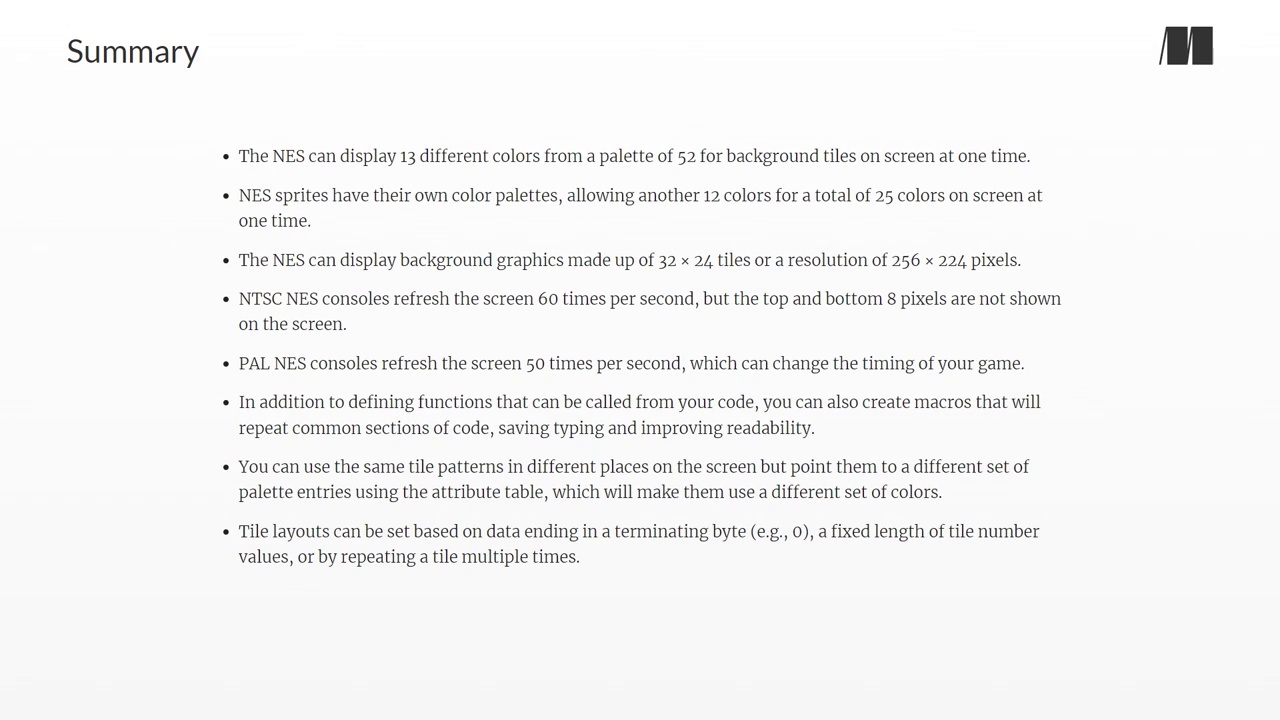Chapter 1. 6502 Assembler
Chapter 1. Calling all retro developers
Chapter 1. Let s program games!
Chapter 1. NES architecture
Chapter 1. Summary
Chapter 1. The structure of a game
Chapter 2. Assembler
Chapter 2. Editor
Chapter 2. Getting set up
Chapter 2. Graphics creation
Chapter 2. Sound effects and music creation
Chapter 2. Summary
Chapter 3. Memory and registers
Chapter 3. Moving things around
Chapter 3. Starting 6502 Assembler
Chapter 3. Summary
Chapter 4. Bytes, bits, and nibbles
Chapter 4. Conditions
Chapter 4. Increasing and decreasing
Chapter 4. Jumps, branches, and calls
Chapter 4. Math, loops, conditions, and bits
Chapter 4. Summary
Chapter 4. Using the stack
Chapter 5. Chars
Chapter 5. Code
Chapter 5. Compile script
Chapter 5. Defined values
Chapter 5. IRQ interrupt
Chapter 5. Initializing the NES hardware
Chapter 5. Main application logic
Chapter 5. NES header
Chapter 5. NES memory configuration
Chapter 5. NMI routine
Chapter 5. RAM
Chapter 5. Some useful functions
Chapter 5. Sprite data
Chapter 5. Starting somewhere
Chapter 5. Summary
Chapter 5. Vectors
Chapter 5. Zero page
Chapter 6. Adding some macros
Chapter 6. Creating a code library
Chapter 6. Defining the tile set
Chapter 6. Displaying the game screen
Chapter 6. Displaying the title screen
Chapter 6. Initializing the console
Chapter 6. NES background graphics
Chapter 6. Starting a game
Chapter 6. Summary
Chapter 7. Controlling timing
Chapter 7. Defining patterns for our player and bullet
Chapter 7. Firing a player bullet
Chapter 7. Move and shoot
Chapter 7. Moving the player s bullet
Chapter 7. Moving the player s ship
Chapter 7. Summary
Chapter 8. Enemy movement
Chapter 8. Step 1 Enemy generation
Chapter 8. Step 2 Enemy movement
Chapter 8. Summary
Chapter 9. Collision detection
Chapter 9. Enemy collisions
Chapter 9. Summary
Chapter 10. Adding to the player s score
Chapter 10. Beating the high score
Chapter 10. Displaying the score on screen
Chapter 10. Keeping score
Chapter 10. Subtracting from the player s score
Chapter 10. Summary
Chapter 11. Animating the player s death sequence
Chapter 11. Displaying the player s lives
Chapter 11. Handling game over
Chapter 11. Player collisions and lives
Chapter 11. Summary
Chapter 12. Changing our enemy movement code
Chapter 12. Changing our enemy spawn code
Chapter 12. Keeping track of enemies
Chapter 12. Making our smart bomb smarter
Chapter 12. More enemies
Chapter 12. Summary
Chapter 13. Animations and more
Chapter 13. Background animations
Chapter 13. Level progression
Chapter 13. Shaking things up
Chapter 13. Summary
Chapter 14. Adding sound effects to our game
Chapter 14. Adding the sound engine
Chapter 14. Creating some sound effects
Chapter 14. Sound effects
Chapter 14. Summary
Chapter 15. Arpeggios
Chapter 15. Generating music data
Chapter 15. Instruments
Chapter 15. Music
Chapter 15. Summary
Chapter 15. Using music in our game
Chapter 16. Extending the NES
Chapter 16. Other types of games
Chapter 16. Publishing your finished game
Chapter 16. Summary
Chapter 16. Where to from here

